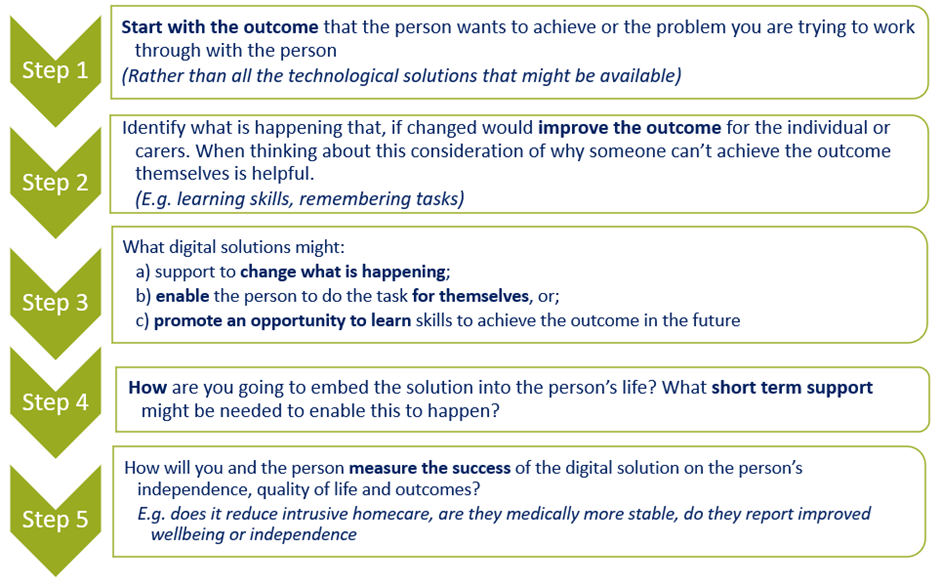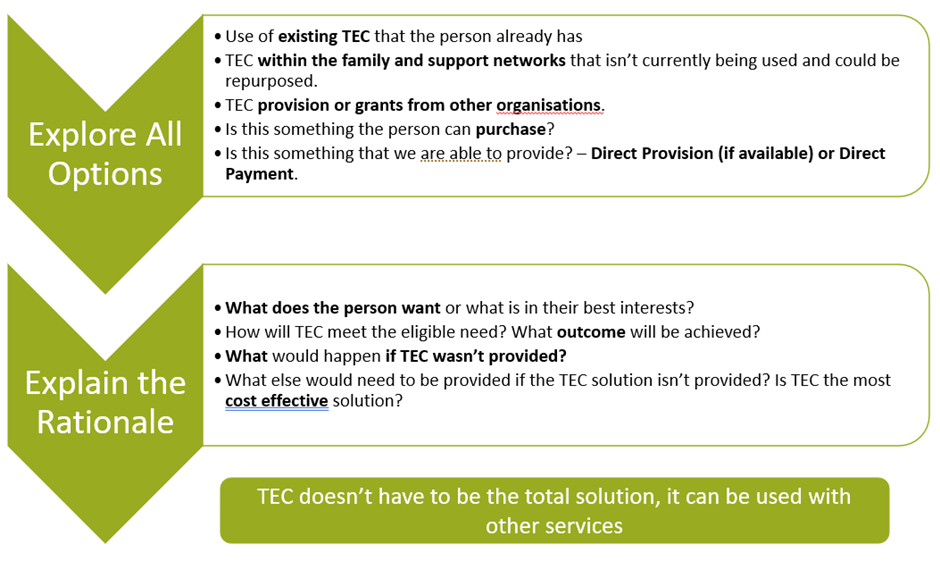Telecare and Technology Enabled Care (TEC)
Scope of this chapter
This guidance should be read alongside the Telecare Guidance and Process Information in the local in the Local Resource Library;
Amendment
In August 2024, this chapter was updated. Section 11, Technology Enabled Care, was also added.
Telecare is the term used to describe the range of equipment that can alert a call centre when, for example:
- a person falls; or
- a person leaves their home unexpectedly; or
- a person needs assistance.
Examples of Telecare equipment include:
- a personal alarm (pendant alarm);
- a falls alarm;
- a door sensor.
Telecare can be provided:
- as part of a Reablement service; or
- to support hospital discharges; or
- alongside services to meet ongoing care and support needs; or
- independent from all of the above.
It is available to people who live in:
- their own home;
- rented accommodation (including Local Authority accommodation);
- supported living;
- extra Care;
- shared lives placements.
Telecare is classified as a preventative service under the Care Act 2014, meaning people can access it without the need for an Adult Care assessment. It is expected that most people will access Telecare this way.
If you believe a person would benefit from the provision of Telecare, you should record in Mosaic:
- That you have explained what Telecare is, and why you think it may be beneficial;
- That this is something the person will need to pay for privately;
- That you have signposted the person or their representative to the Telecare Service provider, or that they wish to arrange the service themselves with an alternative provider;
- If a person declines to have Telecare that they have the capacity to make this decision, or if they do not, that you have considered and followed the Mental Capacity Act 2005 (see Mental Capacity).
Sometimes an Adult Care assessment will establish that Telecare is an appropriate and proportionate way to meet an eligible need.
Guidance on risks that could indicate Adult Care should provide Telecare can be found in section 5 below.
Telecare installation and monitoring costs must be met by the person.
Consideration to funding Telecare will be given where:
- there has been an Adult Care needs assessment and eligibility determination completed in line with the Care Act; and
- the equipment is being proposed as a means of meeting an eligible care and support need; and
- the needs assessment identifies the person is at very high risk of deteriorating physical or mental health, or their safety and emotional wellbeing would be seriously impacted if the identified equipment was not provided.
All decisions to fund Telecare in such circumstances need to be approved by a Lead Practitioner following a review of the assessment and the person’s individual circumstances.
Where Telecare is being provided to meet an eligible care and support need, the entire Telecare system should be funded by LCC. This will cover the cost of the telecare monitoring service and maintenance. The equipment is loaned to the person.
The costs should be included in the person's support plan costings as part of their personal budget, however this cost will be disregarded by the financial assessment team when they complete the person’s assessment.
If Telecare is included in the care and support plan or review, the practitioner should add a full breakdown of costs to the support plan costing. A purchase service request is not required.
If the person has an existing (or developing) Care and Support Plan, any technology or Telecare that is provided to meet ongoing needs must be recorded in the plan.
As every person we work with has a unique set of circumstances, it is impossible to describe every eventuality, however examples of high risks when considering funding Telecare may include:
- an individual with a history of many and frequent falls where Telecare equipment would enable the person to summon assistance;
- an individual with an unstable medical condition where Telecare equipment could support the person to avoid deterioration of their condition or hospital admission;
- an individual who is at risk of harm due to unpredictable behaviour and Telecare equipment may alert others to potential dangers;
- an individual whose carers may be suffering from stress or anxiety and Telecare equipment would enable them to maintain their caring role;
- a vulnerable individual who is at risk of domestic violence, abuse, neglect or other forms of abuse, and Telecare equipment would help them to remain safe.
Practitioners arranging Telecare as part of a Care and Support Plan should do so using Mosaic. The name of the authorising Lead Practitioner should be recorded.
In all other cases, the person should be signposted to the Telecare Service provider.
All monitoring activity should be recorded in line with local recording requirements.
At such time when monitoring is no longer required, it may cease.
Any Telecare that is part of a person's Care and Support Plan should always be reviewed as part of the statutory review of that plan.
Please refer to available guidance in the Service Specific Procedures folder in the Local Resource Library.
Please refer to available guidance in the Service Specific Procedures folder in the Local Resource Library.
Note: If a review has determined that Telecare equipment is no longer required, these arrangements should only be made when any alternative provision to meet needs is in place.
Further details about Telecare equipment can be found in the Service Specific Procedures folder in the Local Resource Library.
Technology Enabled Care (TEC) refers to any digital or technological solution that enables someone to achieve outcomes relating to their care and support needs. TEC solutions range from the simplest information app (application) to sophisticated monitoring devices. TEC includes technology specifically designed for people with care and support needs such as telecare devices, care home call bell systems or lifestyle monitoring sensors, and ‘off the shelf’ household devices such as smart speakers, smart light bulbs or mobile phones.
A TEC first approach should be taken within all conversations, ensuring that the people we work with are able to remain independent and have choice and control in their lives wherever possible. The TEC first approach means considering technology before putting in place other forms of care and support.

This ensures that the least intrusive solutions are considered first and people are supported to make informed choices about the best option for them to remain as independent and in control as possible. Technology can also be used alongside other forms of support to improve outcomes even when people have complex needs or situations.
A strengths based approach should be used in relation to consideration of technology. People’s existing technology use should be viewed as a strength and consideration should be given as to whether they can use existing technology in a different way to achieve outcomes. For example, where someone has a smart speaker that they use to listen to music and they are now forgetting to do daily living tasks, considering if they could they use the smart speaker to remind them to do these tasks.
There is a wide range of technology available so it is important to consider what the right technology is for the person in their unique situation. Some technology requires the person to have a level of ability to use it, other technology will work around the person and is managed by others. The technology solution that is right for one person may not work for another person to achieve the same outcome. Some of the things you might need to consider when thinking about the most appropriate type of technology are:
- The person’s physical and cognitive ability or their potential ability;
- Whether the person needs support to set up or use technology either from their support networks, other organisations or through short term support;
- The person’s home environment and available facilities such as internet which might impact the types of technology they can use;
- Whether there are any risks relating to use of technology and whether any contingencies are in place or needed to mitigate these risks.
You can use this process to help you think through with the person what type of technology might work best for them:

Technology should be considered at every stage of a person’s involvement with Adult Care and we should talk to them about it whenever this is relevant. Knowledge and openness to using technology vary and it is important that we support people to understand how they might be able to use it so that they can make informed decisions. Technology constantly advances and people’s views of it change so even where technology has previously been ruled out it should be considered again.
There are three aspects to consider in relation to technology:
- Maintaining wellbeing and preventing deterioration;
- Using technology to meet eligible needs;
- Enabling people to use technology safely.
Maintaining wellbeing and preventing deterioration
Information and advice are fundamental to enabling people, carers and families to take control of, and/or make informed choices about, their lives. Not only does information and advice help to promote people’s wellbeing by increasing their ability to exercise choice and control, it is also a vital component of preventing or delaying people’s need for care and support.
The Care Act duty to provide information and advice underpins any contact or intervention that the local authority has with the person. Technology can be used in a wide variety of ways to improve quality of life, maintain wellbeing and prevent deterioration. Providing information and advice about technology and signposting people to where they can access further information or support should be integral to our conversations with people.
Using technology to meet eligible needs
Where technology is the best way to meet an eligible need, there are a number of ways to achieve this. Use of existing technology and/or accessing technology through their networks, grant funding or other organisations should be explored with the person.
Where these options have been ruled out and there are unmet eligible needs, the person should be supported to make an informed decision about whether they will fund and arrange technology themselves or whether they need support from the local authority through a personal budget, either through a Direct Payment or, where available, direct provision of technology. In the same way as with other types of support, where the local authority is providing technology, it is important to ensure that as well as achieving the best outcome for the person, it is a cost-effective way of achieving this.
The costs should be included in the person's support plan costings as part of their personal budget, however this cost will be disregarded by the financial assessment team when they complete the person’s assessment.
If technology is included in the care and support plan or review, the practitioner should add a full breakdown of costs to the support plan costing. A purchase service request is not required.

Enabling people to use technology safely
The people we work with are increasingly using technology and the internet to maintain their independence. Developments within the technology sector mean that this is likely to increase further in the future. This has many benefits for the people we work with but there can also be some potential risks related to using technology. We have a responsibility to ensure the people we work with can make informed choices about these risks and how they are managed, which means that it is important to keep up to date with technology, how it can be used and potential risks to be able to identify and take appropriate action when needed.
To find out more about Technology Enabled Care, please access the TEC teams channel where you can find information about TEC, resources to support your learning, and information about development sessions.
For any questions or queries relating to technology please email TEC@lincolnshire.gov.uk.
Last Updated: August 12, 2025
v70